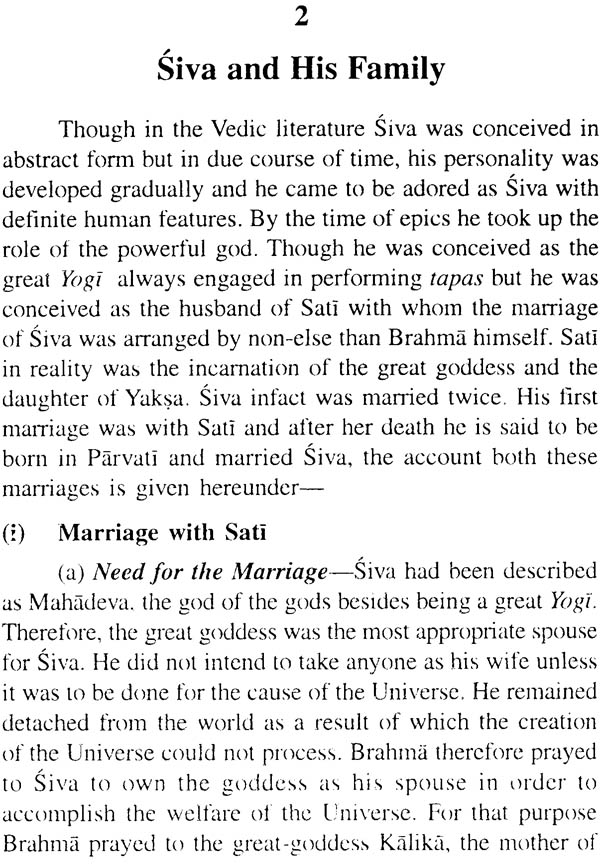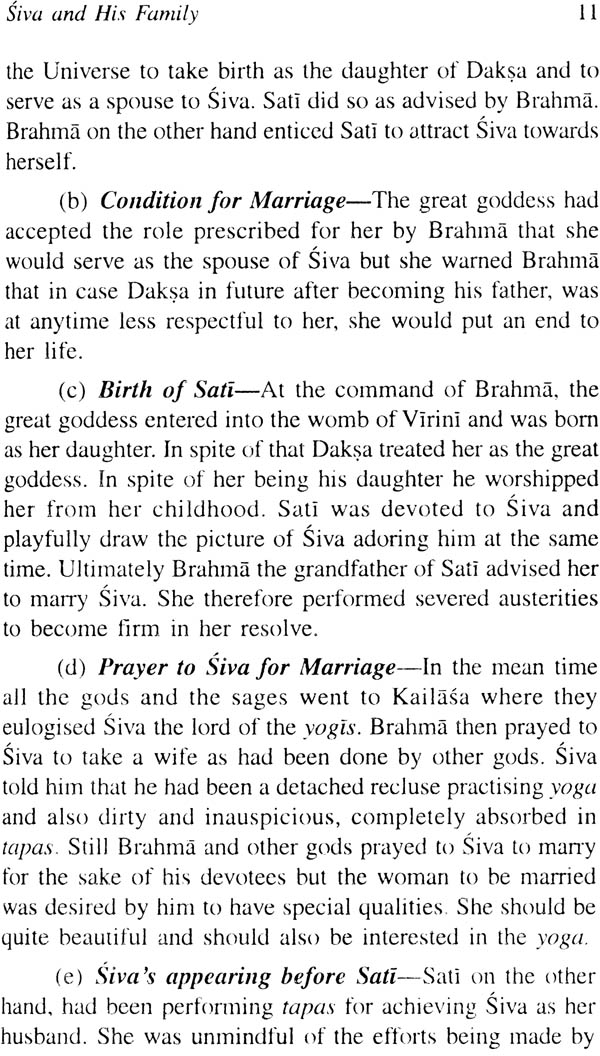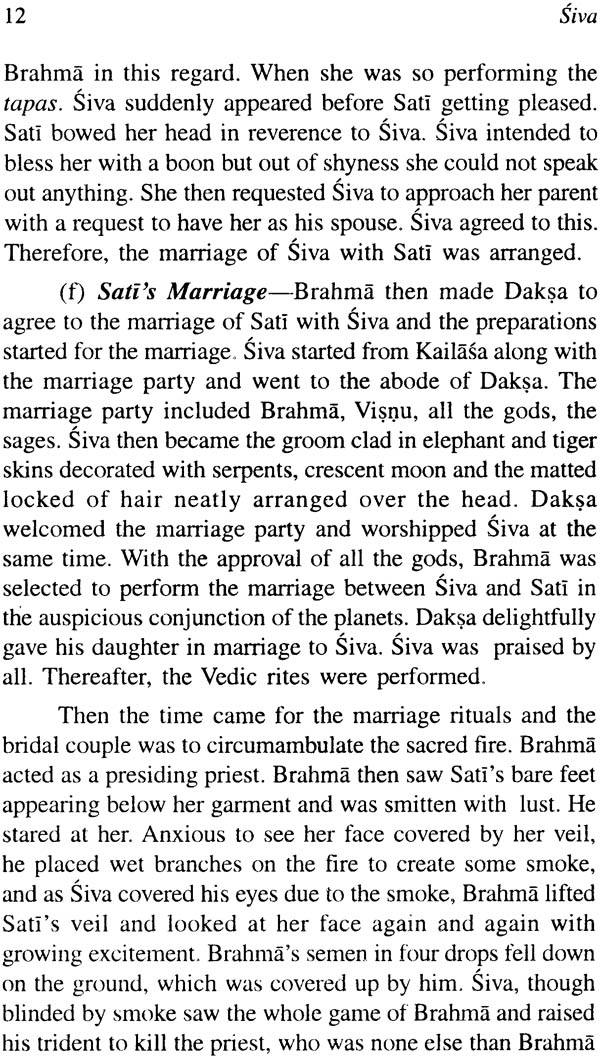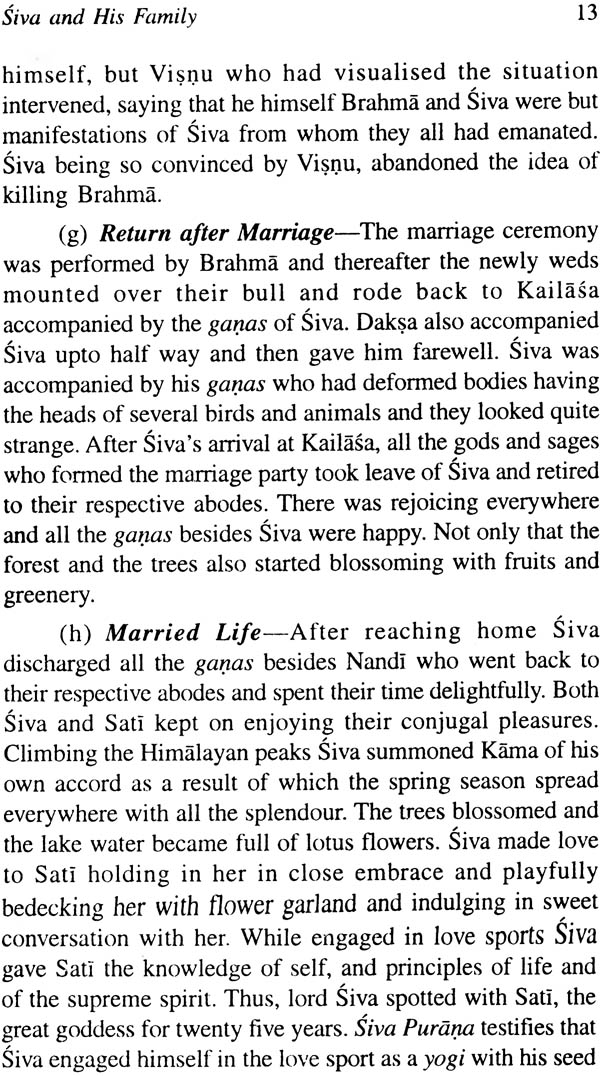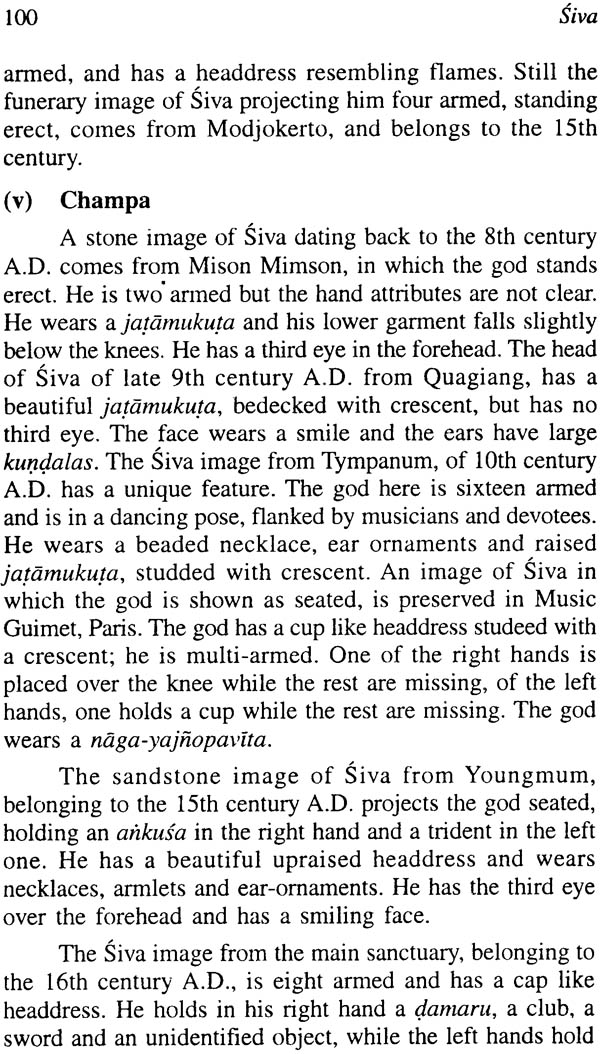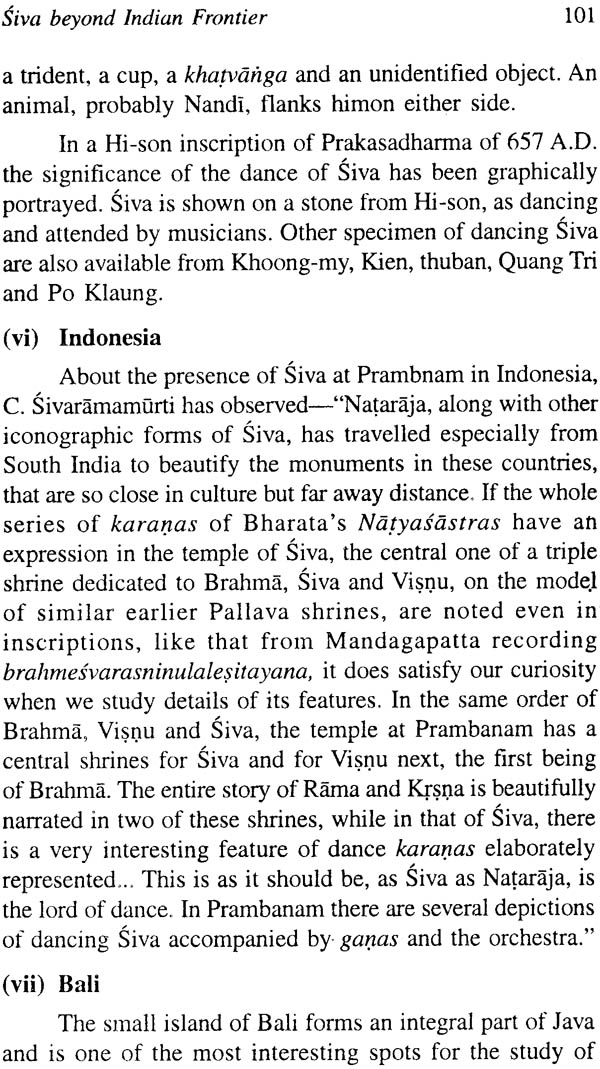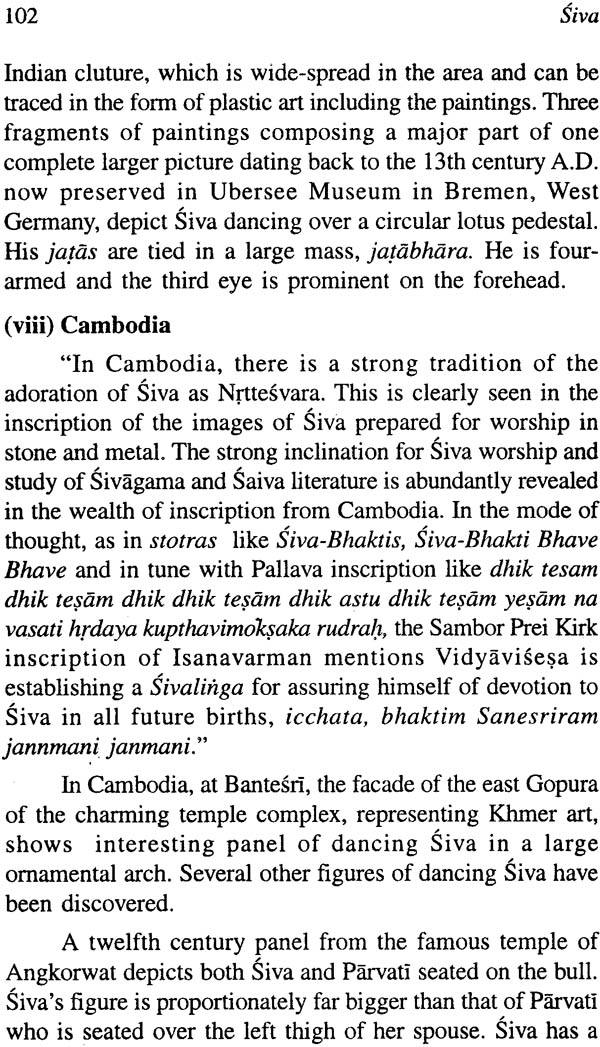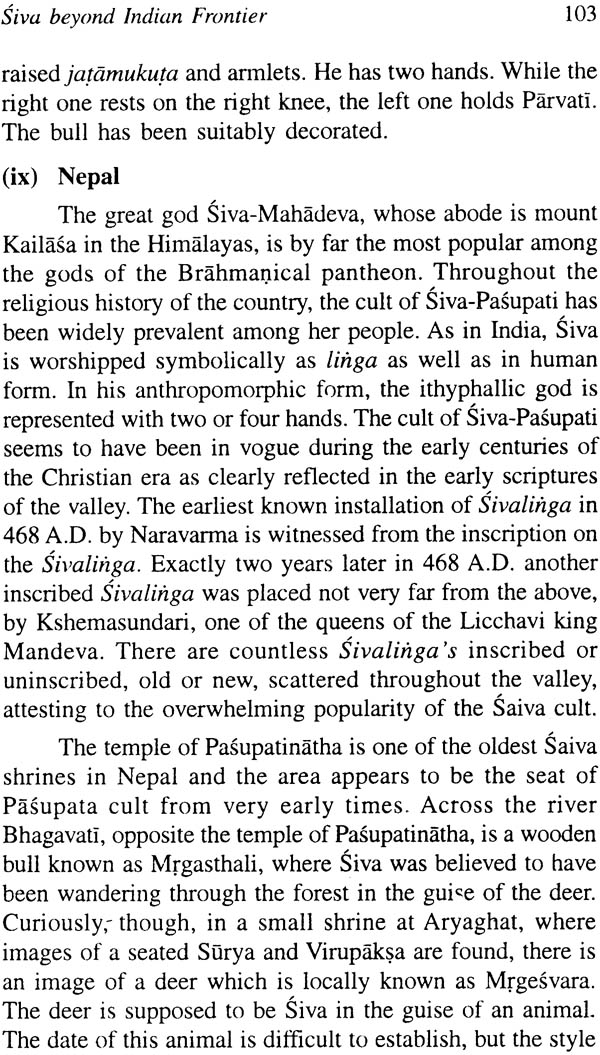
Siva (Shiva The Gracious)
Book Specification
| Item Code: | IDK153 |
| Author: | Shantilal Nagar |
| Publisher: | B.R. Publishing Corporation |
| Language: | English |
| Edition: | 2018 |
| ISBN: | 9788176464796 |
| Pages: | 118 (1 B/W Illustration) |
| Cover: | Hardcover |
| Other Details | 8.7 X 5.7" |
| Weight | 260 gm |
Book Description
About the Book
Siva is the ancient most god of the Hindu trinity and his worship is India is of great antiquity, traces of which are found in the Harappan culture, in Vedic literature and the Puranas besides the Upanisads etc. His temples are found from Kashmir to kanyakumari and from Bengal to the western regions of the country. He indeed had been the great god with enormous following throughout the country. The present account provides the glimpses of his life in brief.
About the Author
Shantilal Nagar, a graduate of the Punjab University, served in the curatorial capacity in the Central Asian Antiquities Museum, New Delhi, the Archaeological Museum, Nalanda, and Archaeological Section of the Indian Museum, Calcutta for a number of years. He has to his credit the scientific documentation of over fifty thousand antiquities, in these museums, representing the rich cultural heritage of the country and comprising of sculptures, bronzes, terracottas, beads, seals and sealing, ancient Indian numismatics, wood work, miniatures and paintings, textiles and Pearce collection of gems, ranging from the earliest times to the late medieval period, He was awarded, in 1987, a fellowship, for his monograph on the temples of Himachal Pradesh, by the Indian Council of Historical Research, New Delhi. He has authored more than fifty books.
India is a land of religion in which several deities were adored from the time immemorial. Some of them had been quite prominent and were following never disappeared ever since, their appearance on the Indian religious scene though some of them disappeared and vanished into oblivion as rapidly as they had mushroomed. Siva happens to be one such deity whose antiquity has been traced in the Vedic literature where he was more popularly known as Rudra and he was, in the later time known as Siva. In the earlier stages he was known in abstract form as Rudra and was considered to be the god of mountains and storms. Keeping in view the antiquity of Siva it may be stated that the Harappan Culture, which goes back to three thousand B.C. has produced the evidence of adoration of Siva, in human as well as symbolic form though it would be difficult to say anything about the name by which he was adored by the Harappan people.
With the passage of time, Siva became more and more popular and was conceived to be the god of mountains, who married the daughter of mountain. He happens to be the lord of the Yogis being the foremost teacher of Yoga. He has been exponent of all the mystic and cult doctrine, religious cults of Tantras, Agamas and Samhitas. In the Vedic texts he has been conceived as the immortal god who has entered the mortal beings. He is wrapped in Samadhi or mental illumination where universal consciousness throws open its innermost secrets to the vision of the man. The powers of the cortex or higher brain are still a mystery to the modern man. But the Yoga- Vidya has discussed the same in orthodox symbolism or a terminology which deserves to be studied and interpreted by modern man who intends to fully understand, the fully chartered map of his true personality, as expressed on the level of mind, material elements and vital airs.
Siva is a most powerful god as the Hindu religion and Saivism is possibly the oldest religious tradition in India. At the earlier stage his true form could not be conceived but at later stage his form was also conceived which went on developing gradually together with other iconographical features. The sun, the moon and the wife are said to be the three eyes of the great god. The fire symbolises the central energy, whereas the sun and the moon are its two-fold extension as heat and cold. Light and darkness are the twine principles of the prana and apana. The centre is called sthanu, the access axismundi of the Universe which is the same as the great arrow, Biina piercing the axial centre of the earth, the atmosphere region and Surya so that the three stand in integration for all time to corne. Time is three-fold but internity is one, it cannot be parcelled out howsoever one may wish to do. Thus, the eternal aspect of the great god reveals undifferentiated and one without a second, though in nature or manifestation it is three-fold. The third eye is infact is characteristic of Siva icon which is placed vertical in the middle in the forehead. The third eye is usually shown as closed because its opening would mean instant destruction. The other two eyes usually remain wide open with almost perpetual stare with eye-balls fully and clearly indicated. Sometimes these eyes are half-open, then it is intended to project the deity under the influence of intoxication as usually done by defeating the gods in the form of Nilakantha. Siva is also known as Mahadeva, Dhurjati, Nilakantha, Trinetra and also appears in Saumya , Ugra and Samhara forms in which different functions are attributed to him for the benefit of gods. Out of these forms Saumya-murti bestow his kindness and blessing to all, who adore him. In his Ugra from he kills the demons, even punishes Kala the god of death. In his Samhara form he killed Andhaka and other terrific demons. He is also the lord of dance and music. As Nataraja, he is the lord of dancers. This is one of the greatest of the names of Siva, and Saivism, especially in Saiva Siddhanta, developed a sophisticated philosophy symbolised in its five-fold activities, Pancakriyas : (i) Srsti (creation and evolution), (ii) sthiti (preservation and protection), (iii) Samhara (destruction), (iv) Tirobhava (embodiment and attraction) and (v) Anugraha (liberation grace and salvation). They reflect the cosmic activity which is the central motif of the dance. The texts testify that creation arises from the vibration of the drum, the damaru, protection proceeds from the hand of hope, i.e., Abhayahasta, from the fire proceeds destruction, the hand pointing downwards represents embodiment, and salvation proceeds from the food held aloft. The root area of the dance is the primal rhythmic energy underlying all phenomenal appearances and activities. In the words of Ananda Comaraswamy, "Here is the perpetual movement, perpetually poised the rhythm of the spirit." Nataraja dances to maintain the life of the cosmos and to give salvation to those who seek him. According to the Bharata's Natyasastra, one hundred and eight variations of dance were performed by Siva at different places on various occasions and the emblems, decorations, and the number of arms differentiate them from one another. Indian images carry some characteristic emblems in their hands to signify the particular attributes of the deity. Saivite images have a large variety of emblems. The images of Siva in dancing poses are available from the earliest times in this country. Wheeler has identified one of the nude ithyphallic bust of a figure from the Indus valley as a prototype of "dancing Siva Nataraja",
| | ||
| 1. | Introduction | 1-9 |
| Siva in Symbolic Form | ||
| 2. | Siva and His Family | 10-47 |
| (i) Marriage with Sati (a) Need for the Marriage, (b) Condition for Marriage, (c) Birth of Sati, (d) Prayer to Siva for Marriage, (e) Siva's appearing before sati, (f) Sati's Marriage, (g) Return After Marriage, (h) Married Life, (i) Daksa's Insult, (j) Sacrifice of Daksa, (k) Sati Ends Her life, (l) Siva's Anger at the Death of Sati, (m) Saktipithas, (ii) Marriage with Parvati (a) Birth of Parvati, (b) Narada's Forecast, (c) Burning of Kamadeva, (d) Tapas of Parvati, (e) Siva's Encounter with Parvati, (f) Marriage of Siva and Parvati, (g) Married Life and Birth of Ganesha, (h) Parvati Becomes Gauri, (i) Ganas of Siva, (j) Virabhadra, (k) The birth of Ganesha | ||
| 3. | Incarnations of Siva | 48-57 |
| (i) Sarabha Incarnation, (ii) Incarnation of Grhapati, (iii) Yaksesvara, (iv) Ekadasa Rudras, (v) Durvasa, (vi) Bhairava, (vii) Hanuman, (viii) Vrsabha, (ix) Pippalada, (x) Vaisyanatha, (xi) Dvijesvara, (xii) Yatinatha, (xiii) Krsnadarsana, (xiv) Avadhutesvara, (xv) Bhiksuvarya, (xvi) Suresvara, (xvii) Brahmacari (xviii) Natanartaka, (xix) Sadhu, (xx) Vibhu-Asvatthama, (xxi) Kirata. | ||
| 4. | Forms of Siva | 58-67 |
| (i) Graceful Forms (a) Grace on Ganesha, (b) Grace of Visnu, (c) Grace on Nandi, (d) Grace on Arjuna, (ii) Other Aspects (a) Siva as a Beggar, (b) Episodes of Ravana, (c) Grace on Ravana, (d) Nilakantha, (e) Sitikantha, (f) Lifting of Kailasa, (g) Association of Snakes and the Moon. | ||
| 5. | The Violent Form | 68-74 |
| (i) Killing of Gajasura, (ii) Punishment to Kala, (iii) Killer of Tripura, (iv) Destroyer of Narasimha, (v) Severing of Brahma's head, (vi) Killing of Jalandhara, (vii) Slaying of Andhakasura. | ||
| 6. | The Composite Forms | 75-78 |
| (i) Arddhanarisvara (a) Siva Purana, (b) Markandeya Purana, (ii) Hari-hara, (iii) Hari-Hara-Pitamaha, (iv) Trimurti | ||
| 7. | Other Forms of Siva | 79-91 |
| (i) Sadasivamurti, (ii) Mahasadasivamurti, (iii) Mahesamurti, (iv) Daksinamurti (a) Vyakhyana Daksinamurti, (b) Yoga Daksinamurti, (c) Jnana Daksinamurti, Vinadharamurti, (v) Visvarupa Siva, (vi) Bhiksatanamurti, (vii) Bhairava, (viii) Siva in form of Birds and Animals (a) As an Elephant, (a) As a Peacock, (c) As a Crane, (d) As a Pigeon, (e) As a Fish, (f) As a Deer, (ix) Natraja, (x) Kali trampling over Siva. | ||
| 8. | Siva beyond Indian Frontier | 92-104 |
| (i) Burma, (ii) China, (iii) Japan, (iv) Thailand, (v) Champa, (vi) Indonesia, (vii) Bali, (viii) Cambodia, (ix) Nepal, (x) Sri Lanka. | ||
| Arati of Siva | 105 | |
